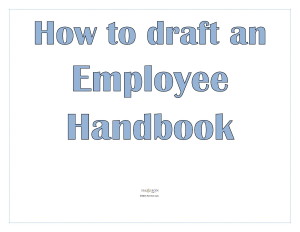The Provisions You Need to Include

Employee handbooks can be a tremendous resource for both employers and their employees. Carefully written employee manuals get everyone on the same page – literally – by clearly outlining company policy, laying ground rules, identifying important objectives, and establishing an overall culture. In general, people thrive when they know what to expect and what is expected of them.
Furthermore, for business owners looking to guard against employment-related lawsuits, employee handbooks provide businesses with an opportunity to set forth clear, concise policies regarding sick leave, personal days, discipline, benefits, work-life balance, inappropriate behavior, compensation, and other important issues.
Getting Started: The Basic Disclaimers
So where to start? In Arizona, and in nearly every other state, your employee handbook should include a disclaimer stating that the handbook is not an employment contract. A business attorney can help you prepare precise language to protect your rights. You should also expressly state that you reserve the right to modify the handbook. Finally, your handbook should include a page, preferably the final page, where the employee will sign, to acknowledge that he or she has read the handbook, understands its contents, and agrees to abide by the guidelines it sets forth.
Employee Rights under State and Federal Law
There are a number of state and federal laws that require employers to inform employees of their legal rights. Many businesses include employee handbook provisions that outline the following state and federal employment laws:
Family Medical Leave Act
The FMLA applies to certain types of employers with 50 or more employees. Businesses that fall under the FMLA must give their workers up to 12 weeks of unpaid leave in a 12-month time period to bond with a new child, care for a sick family member, or deal with the worker’s own health condition. Arizona also provides state family medical leave benefits for state employees; there are no such state-specific laws for private employers.
Equal Opportunity Employer
Many employers include a section indicating that their policies are fully compliant with Title VII and Equal Employment Opportunity Commission (EEOC) regulations.
Workers’ Compensation
Arizona law requires employers to post notices regarding workers’ compensation policies and benefits in conspicuous places. Many employers go one step further by placing this information in their employee handbooks.
Common Employer Policies
Each business is different, but many employers include the following information types of information in their employee handbooks. These items allow both management and the workforce to efficiently handle conflicts, raise questions, and identify solutions that really work.
Appropriate Behavior
This can be a comprehensive section to disclose everything from the company dress code and smoking standards to personal relationships between employees and foul language. Harassment guidelines are often included in this section of the employee handbook as well. Whether harassment takes the form of workplace bullying or inappropriate sexual advances, both forms are distracting and unsettling. Harassment also exposes the employer to significant liability. It is especially important for employees to know to whom in the organization they should report if they are experiencing harassing behavior.
Compensation
Compensation, vacation time, personal days, sick days, health insurance, and other benefits should be very clearly spelled out. Because compensation is something that often varies from employee to employee, consult with an attorney as to whether compensation details should be included within your employee handbook or delivered in separate correspondence.
Computer/Technology Use
In today’s fast-paced business world, many employees use several different forms of technology on an everyday basis. These devices include computers, smartphones, fax machines, tablets, and more. Employers should never assume that employees understand that this equipment is the employer’s property. The employee handbook should make it clear that all communication transmitted on company-owned devices is owned and controlled by the employer.
Conclusion
In conclusion, a well-crafted employee handbook supports employers and employees as they begin and continue their business relationship. Continuous review and revision of your employee handbook coupled with highlighting the company policies contained within will help create a positive and successful corporate culture for your business.
You are reading the final installment of our series on Employee Theft.
For part one of our series on Employee Theft click here.
To find part two of our series on Employee Theft click here.
Part three of our series on Employee Theft can be found here.
© 2015 Matthew W. Harrison and Harrison Law, PLLC All Rights Reserved
This website has been prepared by Harrison Law, PLLC for informational purposes only and does not, and is not intended to, constitute legal advice. The information is not provided in the course of an attorney-client relationship and is not intended to substitute for legal advice from an attorney licensed in your jurisdiction.






